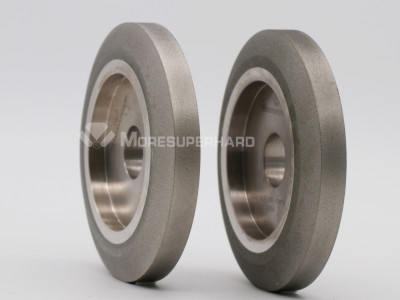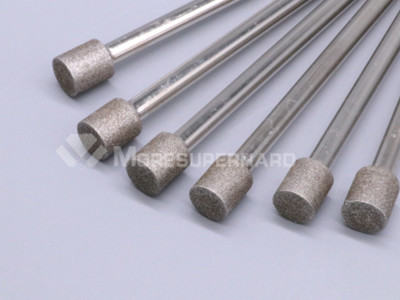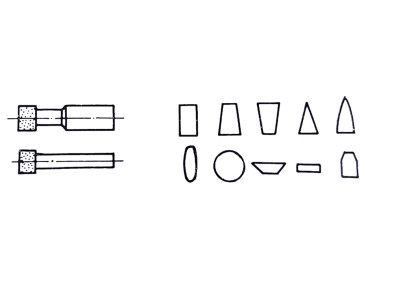

What is electroplated diamond tools?
Diamond is used to make diamond tools for machining hard and brittle materials that are difficult to machine because of its excellent physical and chemical properties such as high hardness, high strength, high wear resistance and low linear expansion coefficient. Diamond tools are made by electroplating, which is a process of electrodeposition of metal to consolidate loose diamond particles in the electroplating layer, giving the diamond particles cutting ability. Diamond tools made by electroplating have low manufacturing temperatures, which avoids heat loss to diamonds. The production process is simple, with less equipment, short manufacturing cycle and convenient molding.
The principle of diamond electroplating
The principle of diamond electroplating is that after the plating liquid and the workpiece are energized, the diamond particles are deposited on the pre-plated workpiece. Then, under the action of the electric field, the nickel will decompose and release nickel atoms, which will be deposited on the workpiece that already has diamond particles. The diamonds on the surface will gradually be wrapped up to form a diamond coating.
Characteristics of electroplated diamond
The products made by electroplated diamond are composed of two parts: the workpiece and the diamond coating. Therefore, this electroplating process can produce various grinding tools with irregular structures, different sizes, thicknesses and high precision. Electroplated diamond usually uses nickel as a binder between diamond particles and the matrix, which will firmly encase 1/2 or 2/3 of the diamond on the workpiece. Because the coating is very hard, this electroplated diamond has very good wear resistance and is less likely to fall off than uncoated diamond. It can also maintain the sharpness of diamond particles for a long time, significantly improving grinding efficiency.


Electroplating diamond process
1. Selection of diamond raw materials
(1) Appearance: Under the premise of certain cost, the purer the better. Pure diamond should be colorless and transparent, but in fact it often appears yellow-green due to impurities and defects. Under metallographic microscope, it is octahedron, rhombic dodecahedron, cube and its aggregate.
(2) Performance: According to JB2808-79, diamond is divided into four types: JR1, JR2, JR and JR4. The higher the number, the higher the hardness, the better the quality and the more expensive the price, but the more expensive the diamond is, the better the performance is. Although JR4 diamond has the highest hardness, it is not as sharp as JR3 diamond. Generally, the two are mixed to maintain good performance and reduce production costs.
(3) Mesh selection: Select diamond with appropriate mesh according to the precision of electroplated diamond tools.
2. Magnetic separation and impurity removal
Because metal catalysts are used in the synthesis of artificial diamonds, there will be some inclusions, so it is generally magnetic. The higher the inclusion content, the stronger the magnetism. Diamonds with strong magnetism not only have many impurities, low strength and poor heat resistance, but also because the magnetic inclusions are conductive, the insulation of diamond particles will deteriorate, which will have an adverse effect on the quality of electroplating and easily form nickel nodules. Therefore, it is not easy to choose diamonds with strong magnetism. In order to avoid the influence of magnetic impurities, it is best to use a professional magnetic separator to remove impurities such as diamonds with strong magnetism before using the diamonds to ensure the purity of the diamonds and thus the quality of electroplated diamonds.
3. Degreasing
Diamonds and electroplated workpieces generally need to be degreased with industrial alkali and then cleaned with ultrasonic waves.
4. Pre-plating
In order to make the diamond and the substrate firmly bonded, the electroplating layer must be wrapped on the surface of the workpiece before electroplating the diamond. If the substrate is stainless steel, pre-plating is required, and if the substrate is carbon steel, pre-plating is not required. The electrolyte is heated to 50°C, and the workpiece is placed in an energized plating tank. After the metal nickel reacts with the electroplating solution, the nickel ions will be deposited on the surface of the workpiece to form a thin electroplating layer.
5. Electroplating
To encapsulate diamond particles on the electroplated layer of the workpiece, there are usually two methods: buried sand method and falling sand method.
01 Falling sand method Complete the sanding of one surface each time, which is more suitable for products with single-sided diamond electroplating;
02 Burial sand method The product that needs to be electroplated with diamond is buried in the diamond particles, so it is more suitable for cylindrical or other irregular products. Their principles are the same. After the electroplating liquid and the workpiece are energized, the diamond particles are deposited on the pre-plated workpiece. Under the action of the electric field, nickel will decompose and release nickel atoms, which will be deposited on the workpiece that already has diamond particles. The diamond on the surface will be gradually wrapped up to form a diamond coating.

6. Washing and drying
After the electroplating is completed, use clean water to rinse the electroplating liquid and diamond particles left between the diamond particles, and then evaporate the moisture on the surface of the product with hot air, so that an electroplated diamond product is completed.
Notic for choosing electroplated tools substrate
The substrate is the cathode in electroplating. Whether the electroplating layer can be completely and evenly covered and firmly bonded to the substrate surface is closely related to the substrate material, geometry, and surface condition. Bases for substrate selection: low carbon steel, low alloy steel, 40# steel, 45# quenched and tempered steel, etc.
① Mechanical properties hardness, strength, rigidity, machinability
② Electrochemical properties The substrate material should have a high hydrogen overpotential to prevent hydrogen from being easily precipitated from the substrate.
Moresuperhard provide electroplated diamond grinding wheel and electroplated diamond mounted points for different materials like carbide,glass,ceramic etc.Moresuperhard provide customized electroplated diamond products for you.If you need,please contact us freely.
<< :Differences between Carbide Milling Cutters and HSS End Mills
<< :The Secret of Vitrified Diamond Grinding Wheel Manufacturing
High-performance diamond composite cutters (PDC) for stone cutting saw blades. Learn key structural features, performance requirements, and selection guidelines for granite, marble, and quarry cutting applications.
Comparison of ns, ps, and fs lasers for PCD, carbide, and ceramic machining, and how Moresuperhard’s 5-axis laser PCD grinding machine delivers high-precision cold laser processing.
Add: Zhongyuan Rd, Zhongyuan District, Zhengzhou, 450001, Henan, China
Tel: +86 17700605088